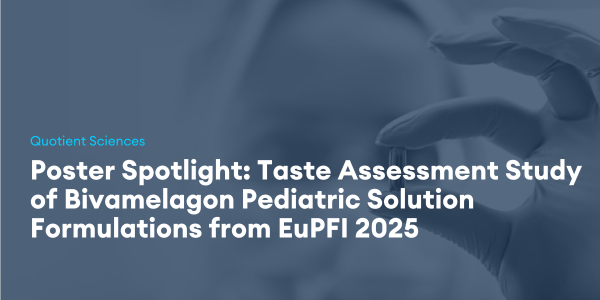Summary: At the 17th Annual Conference of the European Paediatric Formulation Initiative (EuPFI), researchers from Quotient Sciences and Rhythm Pharmaceuticals presented a poster titled “Taste Assessment Study of Bivamelagon (MC72) Pediatric Solution Formulations.”
Poster Spotlight: Taste Assessment Study of Bivamelagon Pediatric Solution Formulations from EuPFI 2025
Read highlights from the poster below and download the poster to see additional findings.
Bivamelagon (MC72; LB54640) is an investigational small molecule agonist of the melanocortin-4 receptor (MC4R), developed for once-daily oral administration to treat MC4R pathway disease-related obesity.
The poster highlighted a collaborative effort to improve the palatability of oral liquid formulation of Bivamelagon for pediatric patients. Quotient Sciences authors Amit Sawant, Nazim Kanji and Phil Evans, along with Rhythm Pharmaceuticals authors Joe Shulman and Anthony Frank contributed to the poster.
Clinical taste assessment study with healthy volunteers
The primary objective was to evaluate the taste profile of Bivamelagon solutions and establish the viability of age-appropriate oral liquid formulations for pediatric use. The current Bivamelagon oral formulation consists of a hydrochloride salt with a bitter taste.
The team aimed to identify simple flavoring and sweetening strategies to mask bitterness and improve acceptability for children. A taste assessment study was conducted with a panel of healthy adult volunteers at Quotient Sciences – Nottingham, UK.
Twelve adult volunteers participated in a randomized, controlled taste assessment where each person sampled oral solution formulations—one reference (Regimen A) and seven test solutions (Regimens B to H)—all containing 10 mg/mL Bivamelagon. The test solutions varied in different levels of sweetener used (sucralose) and different flavors (orange, strawberry, and raspberry).
Participants rated overall acceptability and taste attributes using a 9-point Likert scale. Statistical analyses were performed to compare each test regimen to the reference.
A more palatable formulation for further clinical study
The study found that the reference formulation (Regimen A) was poorly rated for taste and acceptability.
In contrast, all seven test regimens (B to H) showed statistically significant improvements in overall acceptability and palatability attributes. The addition of sucralose, either alone or combined with flavors, consistently improved taste masking.
The median overall acceptability scores for test regimens ranged from 4.5 to 5.5, compared to 3.0 for the reference. A statistical analysis confirmed significant improvements (p < 0.02 for all comparisons vs. reference.
These results demonstrated that simple sweetening and flavoring strategies can effectively mask bitterness and enhance the palatability of Bivamelagon oral solutions. The study concluded that formulations containing sucralose, alone or with fruit flavors, are suitable for further development and progression to pediatric patient studies.
Browse more about our pediatric offering
To get alerted about new blogs, news, and updates from our company, make sure you're on our mailing list. Subscribe for email updates.

